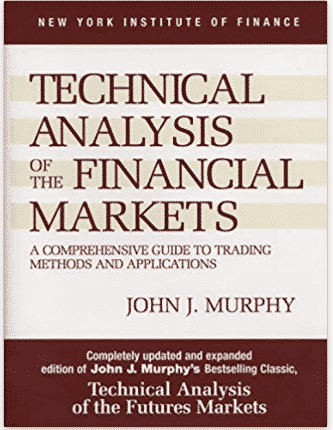

When people ask me what’s a good book on technical analysis, one of the books that I often mention is John Murphy Technical Analysis of the Financial Markets: A Comprehensive Guide to Trading Methods and Applications.
The Greeks and technical analysis are the two fundamental pillars to learn when trading options.
While this book is not about options, it is the bible on technical analysis.
With over 570 pages, it is just about as comprehensive as it gets.
If you get the Kindle or Audiobook version, then you don’t have to lug around the 2.8-pound hardcover book.
Contents
- Definition and Premise
- Fundamental versus technical analysis
- Building Blocks of Chart Analysis
- Reversal and Continuation Patterns
- Volume
- Moving Averages
- Oscillators
- Other topics
- Building a Trading System
- Money Management and Diversification
- Summary
John Murphy’s four decades of market experience include Director of Technical Analysis at Merrill Lynch, Technical Analysis for CNBC, and Chief technical analysis for Stockcharts.com.
Over the years, he has been on various media, including Bloomberg TV, CNN’s Moneyline, Nightly Business Report, and Wall Street Week.
In one interview, he says that anyone can learn technical analysis.
You don’t need to learn all the esoteric details.
Just grasping the half-dozen or so of the fundamental principles of technical analysis could significantly enhance one’s trading.
When he first started, he drew charts by hand — personal computers were not invented yet.
During his time teaching at New York Institute of Finance, he wrote this book along with the companion study guide.
Definition and Premise
The book defines technical analysis as:
“the study of market action, primarily through the use of charts, for the purpose of forecasting future price trends.”
It is based on three premises:
- Market action discounts everything — all information is already baked into the price
- Price move in trends — when the price is in a trend it is more likely for it to continue in that direction than to reverse
- History repeats itself — price action is driven in part by human psychology (which hasn’t changed much since the beginning of history)
Fundamental versus technical analysis
John Murphy favors the latter, writing that:
“market price acts as a leading indicator of the fundamentals.”
and that,
“The fundamentalist studies the cause of market movement, while the technician studies the effect.”
The effect is all that we need to know. Knowing the cause is unnecessary.
He also discounts the Random Walk Theory saying that:
“The illusion of randomness gradually disappears as the skill in the chart reading improves.”
The book then goes into the tenents of the Dow Theory and the types of charts (line, bar, candlestick, point and figure, etc.) and timeframes.
Building Blocks of Chart Analysis
Murphy is a big believer in trading in the direction of the trend.
Buy on pullbacks of an uptrend, for example.
Chapter four is about trends and the building blocks of chart analysis, including support/resistance, trendlines/channels, retracements, and the fan principle.
He explains how support and resistance can change roles.
When price breaks above resistance, that resistance line can become support.
A top reversal day is when a candle makes a new high in a uptrend but closes below the previous day’s close.
A bottom reversal day is when a candle makes a new low in a downtrend but closes above the previous day’s close.
The pattern is more significant on higher volume and when spotted in weekly or monthly charts.
Three types of gaps are discussed:
- Breakaway gaps — occurs on high volume and usually not filled. Usually signals the completion of a basing pattern.
- Runaway or measuring gaps — occurs in the middle of a trend and not usually filled.
- Exhaustion gaps — occurs at the end of a market move. Price falling below this gap in an uptrend signals a reversal.
The island reversal is when a series of candles is formed by a gap and before and after it.
If you are going to read one chapter of this book, this chapter is it.
Reversal and Continuation Patterns
A trend will continue until it reverses.
Chapter 5 covers the five most commonly used reversal patterns:
- head and shoulder
- double/triple tops/bottoms
- the saucer
- the V
- the spike
Murphy goes into the nuances of the head and shoulders pattern as this is the best known and the most reliable of all the reversal patterns.
This includes the failed head and shoulders pattern and the inverse head and shoulders pattern.
This is followed by chapter 6, which covers continuation patterns:
- triangles — symmetrical, ascending, descending, broadening
- flags and pennants
- The wedge
- Rectangle
The measured move and divergence are briefly discussed.
Volume
Chapter 7 is about volume. He writes:
“By monitoring the price and volume together, we’re actually using two different tools to measure the same thing — pressure.”
The On Balance Volume (OBV) indicator follows price typically, but when there is a divergence, that gives us a clue.
For options, the put volume ratio to the call volume indicates either bullish (when the ratio is low) sentiment or bearish (when the ratio is high).
Moving Averages
A technical analysis book would not be a technical analysis book if it did not include a chapter on moving averages.
Chapter 9 discusses various moving averages crossover techniques — from a single moving average to triple moving average systems.
A moving averages trading system forces the trader to trade in the direction of the trend.
As such, they work best in trending markets.
Unfortunately, one-third to half of the time, the markets are not trending.
Chapter 15 talks about the ADX indicator, which can tell the technician whether the market is trending or not.
Bollinger band is a band at a certain standard deviation (typically 2 SD) price that moves out from a moving average.
Since the standard deviation changes, the bands can get wider or narrower.
Murphy suggests using the upper and lower bands as price targets.
The chapter concludes with the 4 Week Rule system and variation thereof.
Oscillators
When the market is not trending, the use of oscillators becomes important, as discussed in chapter 10.
These include Momentum oscillator, RSI, MACD, Stochastics, and Larry William %R.
Oscillators are most valuable when they are in oversold or overbought values, especially when they show a divergence in price.
There are a series of images in the book showing examples of RSI divergences.
The 50 level in the RSI will often act as support during pullbacks.
Other topics
The book discusses the concept of divergence, Elliot Wave Theory, Fibonacci retracements, cycles, and Intermarket analysis.
Chapter 19 contains a 23-point technical checklist. Some points in the checklist include checking:
- direction of market/sectors
- support/resistance,
- trendlines/channels,
- the 33%/50%/66% retracement levels
- reversal/continuation patterns
- direction of moving averages
- oscillator in overbought or oversold
- divergences
- Elliot Wave pattern
- Fibonacci retracement/projections
Building a Trading System
Appendix C explains the five steps in coming up with a trading system:
-
Start with a concept.
Is the system trend or counter-trend?
Or is it based on a pattern?
What indicators to use?
-
Turn the concept into a set of object rules.
Next, construct rules for every scenario.
The more detailed, the better.
-
Visually Check it out on the charts
Go through some chart examples using the rules, kind of like a manual backtest.
-
Formally test it with a computer
Test across different parameters, time frames, and markets.
-
Evaluate results
This is where we determine the profit factor, average P&L per trade, and max drawdown.
The profit factor is gross profit on winning trades divided by gross profits on losing trades.
In other words, it tells us the number of dollars that are won for every dollar lost.
This number should be two or higher for long-term traders.
It can be less for shorter-term trades.
The average P&L is the expectancy.
It should obviously be positive.
The max drawdown is important for tradability.
If the max drawdown is large and trade allocation is poor, the portfolio can be out of money before the profitable wins come.
Other factors to consider:
- will the drawdowns be too large for the trader to easily weather
- how quickly it exits losers
- how long it stays with winners
Money Management and Diversification
The book closes with a few paragraphs on money management.
Murphy concedes that this “extremely important topic” is outside the scope of the book.
What he does write is that:
“It is the key to profitable trading, every bit as important as a good trading system. … Control your downside, and profits will take care of themselves.”
Murphy says too
“Diversify among markets, systems, parameters, and time frames.”
This will enable you to decrease risk while holding your returns constant or increase your returns without increasing your risk.
Summary
With such a large book, it helps to have a high-level view of the summarizing concepts:
- Trade in the direction of the trend
- Buy at support, sell at resistance
- Watch for reversal pattern (head and shoulders, double/triple tops and bottoms) and divergences
- Common retracements are 33%/50%/66%
- Using moving averages in trending markets
- Use oscillators in non-trending markets.
For those who are deep into technical analysis, this is the book to have.
Trade safe!
Disclaimer: The information above is for educational purposes only and should not be treated as investment advice. The strategy presented would not be suitable for investors who are not familiar with exchange traded options. Any readers interested in this strategy should do their own research and seek advice from a licensed financial adviser.
Amazon Associate Disclosure
Options Trading IQ is a participant in the Amazon Services LLC Associates Program, an affiliate advertising program designed to provide a means for sites to earn advertising fees by advertising and linking to amazon.com











